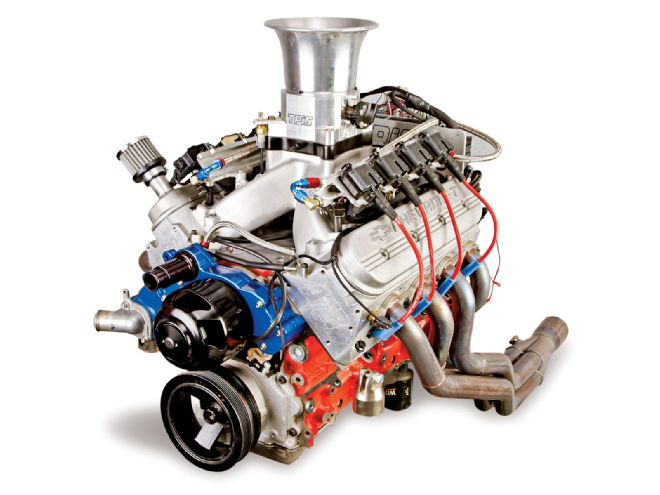
Editor's Note: The following story was written by ex-Popular Hot Rodding Tech Editor Scott Parkhurst, who was instrumental in the conception and development of the AMSOIL Engine Masters Competition almost 10 year ago. Scott has since moved on from PHR, and now works as a consultant and freelancer in the performance industry. Nevertheless, Scott's affinity for the EMC is so great that he just couldn't stay away from his first love. For the 2009 competition, Scott collaborated with Tuned Port Injection Specialties (Chaska, Minnesota) to bring one of the first-ever fuel-injected engines to the fray. As seen here, the 383ci LSX scored 2,411.8 points (18th out of a field of 30 engines). After this story was written, this same engine made an appearance at the 2010 event. With a change to a smaller cam, a bigger oil pan, and a different intake-brought on by a reduction in the rpm range of the competition-the TPIS LSX scored 2,314-good enough for Sixth Place out of 35 entries. Scott's experience as PHR's tech editor, EMC creator, and finally as an active partner on an EMC team gave him a unique 360-degree perspective of the AMSOIL Engine Masters Challenge that is not likely be repeated. This is his story! -Johnny Hunkins
When TPIS and this author decided to combine forces to enter the Engine Masters Challenge competition in 2009, we wanted to develop the best possible LS-based EFI-fed engine we could. Certainly we were anxious to compete against many of the world's best engine experts, but there was also the desire to use this development mule as a blueprint for future crate-type offerings. While TPIS specializes in custom-designed engines of all types for street, strip, circle track, and road course competition, the GM LS V-8 is quickly becoming the powerplant of choice for many enthusiasts. Realizing this, TPIS wanted to offer a line of well-designed and engineered LS-based engines at several different power levels and prices to accommodate the needs of enthusiasts everywhere. For the Engine Masters Challenge, this would be their first year competing, and while they had no fantasies of walking in as rookies and walking out with the big trophy and that big check, TPIS did want to learn how this game is played. TPIS has every intention of becoming a regular competitor in this event, and this particular engine will continue to undergo development and evolution to become a serious contender for the top spot. In 2009, the effort was a chance to begin this quest, and fire a warning shot over the bow of the competition.
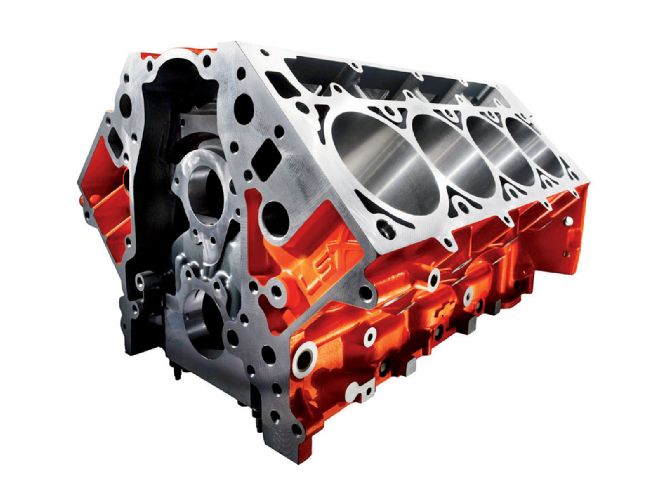 The LSX block was designed for extreme performance and racing applications. When compared to production line LS blocks, the LSX boasts a thicker deck surface where the heads bolt up, and more mass surrounding the critical bottom end main bearings. More than 2,000 hp has been made with an LSX block, so the design has been proven beyond what we'll ever see in a Challenge engine.
The LSX block was designed for extreme performance and racing applications. When compared to production line LS blocks, the LSX boasts a thicker deck surface where the heads bolt up, and more mass surrounding the critical bottom end main bearings. More than 2,000 hp has been made with an LSX block, so the design has been proven beyond what we'll ever see in a Challenge engine.
The final results were sobering, as TPIS finished about mid pack and learned many valuable lessons, which will contribute greatly toward placing higher in the future. Nevertheless, the engine was one of the first to run electronic fuel injection in Engine Masters Challenge competition; it ran well and experienced zero issues throughout. Nothing failed, nothing was damaged, and the TPIS crew developed as a team.
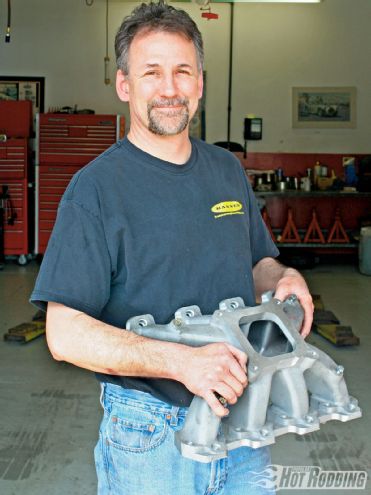 Engine builder Clay Witt has been working at TPIS almost as long as the shop has been open. He's assembled countless performance engines from mild vintage engines for cool hot rods to full-race Chevy V-8s for IMSA Trans-Am competition. He's been working with the LS family of GM V-8s as long as they have been available, and knows all the tricks to make them both powerful and durable for the long haul. Witt is seen here holding TPIS's own single-plane EFI intake for the LS, which TPIS intends to use on their Challenge engine.
Engine builder Clay Witt has been working at TPIS almost as long as the shop has been open. He's assembled countless performance engines from mild vintage engines for cool hot rods to full-race Chevy V-8s for IMSA Trans-Am competition. He's been working with the LS family of GM V-8s as long as they have been available, and knows all the tricks to make them both powerful and durable for the long haul. Witt is seen here holding TPIS's own single-plane EFI intake for the LS, which TPIS intends to use on their Challenge engine.
TPIS began the development of the Engine Masters Challenge entry with a clean sheet, and discussed all of the relevant points and variables as a team. We agreed on just about everything, from the critical cylinder head choice to some loose camshaft and intake basics. Surely we'd have some variables to figure out and fine-tuning to accomplish, but the major hardware choices were narrowed down almost immediately.
Beginning with a GM LSX block, we knew the foundation of our Challenge entry would be a solid one. The LSX block is designed to support big power, and the additional strength in critical areas would ensure we didn't have any issues here. We know LSX blocks have shown the capability to withstand 2,000 hp, and our target peaks would be less than half of that. We simply wanted an absolutely rock-solid foundation to build upon, and we got it with the LSX.
We topped the block with Air Flow Research (AFR) heads, which we received in CNC-finished form. We didn't want to make any major mods to the heads, since AFR has done a great job of designing and finishing them-we wanted to work with them as-is since they are so good out of the box. Thanks to Tony Mamo at AFR for his advice and guidance on our game plan. The heads ship with 240cc intake ports, 2.165-inch intake, and 1.60-inch exhaust valves, and they flow very well as-delivered. We felt we could determine the capabilities of the heads, and then build the rest of the engine around them to maximize efficiency. They were flowed on the in-house bench at TPIS (so all previous flow data and results accumulated on the same bench could be used for relative comparison) and the plan evolved from there.
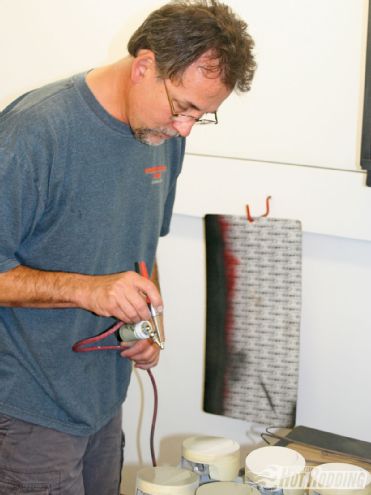 Coatings were used extensively throughout the TPIS Challenge entry. Here, Witt sprays the piston tops with a ceramic coating after cleaning them. The ceramic coating spreads the heat in the chamber over a wider area, minimizing hot spots and keeping detonation at bay. TPIS applies all of their own coatings in-house, and offers these services to clients as well.
Coatings were used extensively throughout the TPIS Challenge entry. Here, Witt sprays the piston tops with a ceramic coating after cleaning them. The ceramic coating spreads the heat in the chamber over a wider area, minimizing hot spots and keeping detonation at bay. TPIS applies all of their own coatings in-house, and offers these services to clients as well.
Once we completed flow testing, we settled on the 383ci displacement level as one the heads were fully capable of feeding. Team leader Myron Cottrell says: "I wanted to keep displacement under control. It would have been easy to stroke the engine out to over 420 cubes and produce some big numbers, but we had to focus on efficiency here. The valves needed to be completely unshrouded, but it's easier to get horsepower-per-cubic inch efficiency from lower displacements, and we knew there would be a size limitation on the exhaust pipe diameter. This meant all the competitors would be breathing through the same diameter exhaust pipes, so a smaller displacement engine should have some advantage over a larger one breathing through the same pipe in this rpm range. [3,000-7,000 rpm-ed.] The 383 displacement would be able to make good torque, and with the single-plane intake manifolds we were considering, we knew it could make good power right up to the 7,000-rpm ceiling."
The TPIS team also knew they'd be running the ultrastable race-proven Jesel 1.7:1 rocker assemblies. We shared our airflow and target displacement figures with Cam Motion and also with COMP Cams, and respectfully accepted their input and suggestions on potential profiles to test. Four camshafts were soon on their way to the shop.
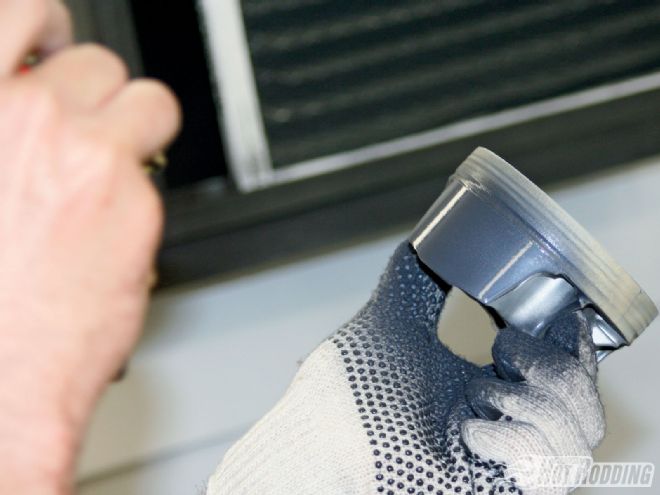 After the piston tops got their ceramic coating, the piston skirts got a graphite-based coating to minimize friction and heat as they travel up and down in the bores. The coatings are applied with a basic airbrush, and are Tech Line products. Note the ring grooves are taped up to prevent any of the coating from getting into them-the clearances in this area are crucial and the ring lands should never be coated.
After the piston tops got their ceramic coating, the piston skirts got a graphite-based coating to minimize friction and heat as they travel up and down in the bores. The coatings are applied with a basic airbrush, and are Tech Line products. Note the ring grooves are taped up to prevent any of the coating from getting into them-the clearances in this area are crucial and the ring lands should never be coated.
The intake manifold was the next major component to choose. We considered all the factory-type (front-fed) and traditional (top-fed four-barrel type) intakes that were commercially available and legal for use in the competition. We decided that the four-barrel style would be best, and ended up testing several different types before settling on the Edelbrock Super Victor. We learned that the longer the runners were, the greater the power and torque potential existed in the target EMC rpm range of 3,000-7,000 rpm. This greater-length theory extended right up into the throttle body, as our testing showed greater returns from taller examples. TPIS manufactures several different throttle bodies for use in these configurations (mounted like four-barrel carbs on EFI applications) and the tallest one delivered the best results. In fact, the 102mm "tall" TPIS throttle body was some 20 lb-ft better in testing than a standard-height unit (up to 5,000 rpm).
We also tested a wide range of exhaust headers. TPIS manufactures several excellent long-tube designs that we felt would work well in the Challenge competition, including their late-model Pontiac GTO and Cadillac CTS-V offerings in stainless steel. Previous testing had shown them to be great performers over a wide rpm range, but a check into the EMC rules showed the previous callout for a chassis assignment for the headers was no longer required. This opened the door to other designs, and we acquired a couple sets of headers from American Racing Headers to test. This proved to be a good move, as we found power in American Racing's 1.750-inch/1.825-inch stepped diameter, 26-inch-long primary pipe Corvette headers with 18-inch-long collectors.
Once we'd received four camshafts to test (with minor deviations in lobe centerline, duration, and overlap) we found the best numbers using a Cam Motion grind with 255/262 degrees of duration at .050-inch lift, and .707 and .680 inches of valve lift on the intake and exhaust sides, respectively.
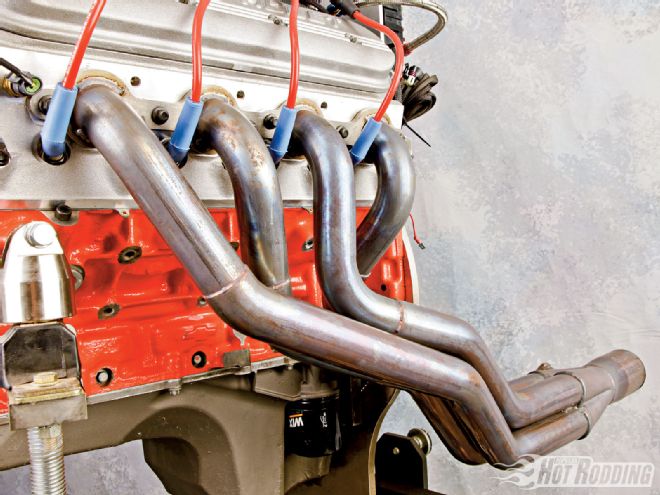 The Manley-crafted connecting rods were also beautiful and lightweight. These are their "Tour Lite" I-beam rods in a 6.125-inch length. They ship with ARP 2000 bolts and are bushed for use with a full-floating piston. These rods carry PN 15345C-8 and are a great choice for serious LS powerplants. The average big end weight on these rods is 368g; the pin end average is 175g.
The Manley-crafted connecting rods were also beautiful and lightweight. These are their "Tour Lite" I-beam rods in a 6.125-inch length. They ship with ARP 2000 bolts and are bushed for use with a full-floating piston. These rods carry PN 15345C-8 and are a great choice for serious LS powerplants. The average big end weight on these rods is 368g; the pin end average is 175g.
Our reciprocating assembly choices were twofold. We ordered up a flyweight (40.3-pound) custom crank from Callies to minimize reciprocating mass, and hoped that this crank (teamed with lightweight Manley forged rods and custom-crafted 459g CP pistons incorporating ultrathin .032-inch-thick Total Seal top and second rings) would deliver more power than heavier, more readily available parts. It's certainly proven to make a difference in the acceleration rates of competition cars that have powerplants so equipped. But these parts would require waiting while they were being crafted, so we went with more pedestrian parts to complete the testing. We'd go through the rebuild once again just before the Challenge competition, and drop our flyweight "jewelry" into the crankcase at that time. Since the basic dimensions (crankshaft stroke, connecting rod length, piston pin height) would remain identical, this was a solid plan and we'd be able to see the benefit of the lighter parts in back-to-back testing.
Unfortunately, we didn't see the substantial power gains we'd hoped for post-rebuild. We did see 5-plus horsepower across the board, but considering the substantial investment these lightweight parts command, the power benefit hardly seemed worthwhile. We reasoned that the true benefit of such parts (faster rate of acceleration) was snuffed by the computer-controlled acceleration rate on the dyno.
 After testing several different headers, TPIS found the best average power and torque with these pipes from American Racing Headers (ARH). They're a step design, going from 1.750 to 1.875 inches before tapering down to a 2.5-inch collector choke.
After testing several different headers, TPIS found the best average power and torque with these pipes from American Racing Headers (ARH). They're a step design, going from 1.750 to 1.875 inches before tapering down to a 2.5-inch collector choke.
Additionally, this final pre-Challenge rebuild would give us the benefit of inspecting all of the engine's internals to ensure all was up to snuff right before the competition. Once accomplished, everything was found to be just fine. The only work done (besides the previously mentioned reciprocating assembly swap) was a tiny touch on the valve seats. They didn't really need it, but as Myron says, "After 600 dyno pulls, I had to touch the valve seats. It was just for insurance, so I could sleep knowing they were as good as they could be." No other changes were made to the heads.
One area we admittedly should have invested more attention in was the oil pan. We used a factory "truck" oil pan, and after speaking with other LS-based competitors at the Challenge, this may have cost us some power.
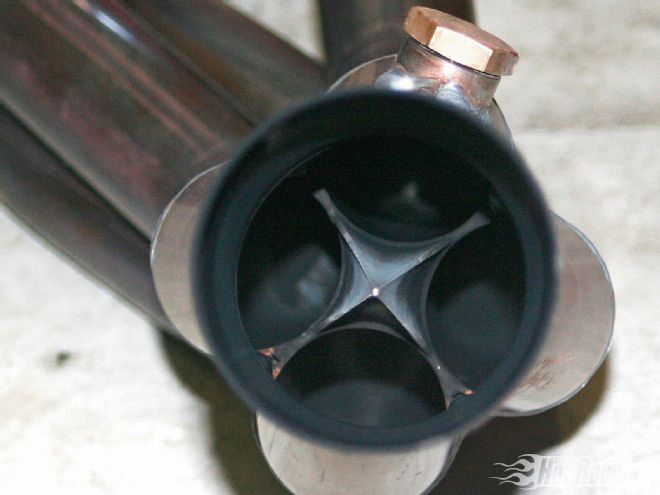 The headers also boast an intricately formed goilet where the four primary pipes join as they enter the collector before feeding into MagnaFlow mufflers. The quality of these headers is first-rate, from the pristine clean welds, to the thick flange mount where they bolt up to the heads.
The headers also boast an intricately formed goilet where the four primary pipes join as they enter the collector before feeding into MagnaFlow mufflers. The quality of these headers is first-rate, from the pristine clean welds, to the thick flange mount where they bolt up to the heads.
"We should have just made an oil pan," Cottrell says. "The truck pan we used has a deep sump, but the front of the pan is quite close to the crankshaft. I think that might have been an issue, and some clearance there may have helped a little." As it was, using the stock pan and stock pickup with oil pressure limited to 45 psi, there were no lubrication issues after hundreds of 7,000-rpm pulls. The setup works reliably, but there may be more power on the table here. The engine was broken-in using Gibbs Break-in Oil, which proved to work extremely well compared to typical parts store oil typically employed for this purpose.
The engine was outfitted with Bosch's outstanding HO7DC spark plugs, ignition timing was programmed in at 26 degrees of total advance from 2,500 rpm up to 7,000, and we were ready to go. Once at the competition, the only real surprise came in the form of coolant temperature. The EFI computer is programmed to bring the engine up to operating temperature (typically 180 degrees, minimum) and make big power there. Until it reaches that point, the computer will run the fuel mix a bit rich (functioning loosely like a choke on a carburetor). Once on the Challenge dyno, the engine was pulled at only 143-150 degrees of coolant temperature and was understandably rich throughout the pull. Our between-rounds tune-up addressed this as much as we could, but it was still rich when our time ran out, and this cost us on the final tally. The TPIS crew learned from this, and will be better prepared next time.
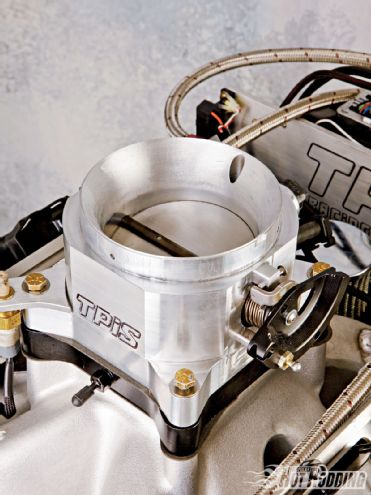 On the inlet side, several different combinations of throttle bodies and intake manifolds were tested before a final combination was chosen. TPIS experimented with throttle bodies from 90 to 102mm, and in several different heights. The best overall performer was the tallest TPIS 102mm unit, used in combination with a 1-inch Holley carb spacer.
On the inlet side, several different combinations of throttle bodies and intake manifolds were tested before a final combination was chosen. TPIS experimented with throttle bodies from 90 to 102mm, and in several different heights. The best overall performer was the tallest TPIS 102mm unit, used in combination with a 1-inch Holley carb spacer.
The maximum effort called for by the Engine Masters Challenge forced our crew of experienced performance engine specialists to go back to basics and put what we knew to the test. We learned a lot from start to finish, as the in-house dyno served as our guide while the other competitors gave us inspiration and direction to push the limits even further. Such an engine could serve as a phenomenal street or track engine, with ample power on tap throughout the sub 7,000-rpm range on pump gasoline.
Based on what was learned, TPIS will be offering several LS-based combinations capable of producing broad-based power on low-octane pump gas. These, too, will evolve, like the Challenge entry engine itself, but durability and reliability will remain priority one. With the LS design as a foundation, the future of pump-gas powerplants from TPIS is bright. When the dust settled, the diminutive 383-cube LS bullet belted out 629 peak horsepower at 7,000 rpm-that's well into big-block territory. It's also a warning shot across the bow that TPIS is a player in the wonderful world of LS power.
BY THE NUMBERS TPIS LSX 383 Bore: 4.101 inches Stroke: 3.625 inches Displacement: 383 ci Compression ratio: 11.3:1 Camshaft: Cam Motion solid roller Valve lift: .707/.680 inch Duration at .050: 255/262 degrees Rocker type/ratio: Jesel 1.7:1 Pistons: CP forged Top ring: Total Seal .032 Second ring: Total Seal .032 Oil ring: Total Seal 3mm Block: GM LSX Crank: Callies forged Rods: Manley forged Heads: AFR aluminum, CNC 240cc Intake valve: 2.165 inches Exhaust valve: 1.60 inches Intake: Edelbrock Super Victor, port-matched Throttle body: TPIS 102mm EFI controller: GM Wiring harness: Howell Engine Management Programming: TPIS/LS1 Edit Headers: American Racing with 1.75-inch primary Ignition: GM
DYNO DATA TPIS 383 RPM TQ HP 3,000 443.6 253.4 3,100 444.4 262.3 3,200 438.4 267.1 3,300 429.5 269.9 3,400 417.4 270.2 3,500 399.9 266.5 3,600 387.6 265.7 3,700 389.9 274.7 3,800 399.3 288.9 3,900 415.4 308.4 4,000 433.9 330.4 4,100 448.3 350.0 4,200 462.7 370.0 4,300 473.9 388.0 4,400 484.6 406.0 4,500 491.7 421.3 4,600 496.8 435.2 4,700 501.0 448.2 4,800 506.0 462.2 4,900 510.0 475.9 5,000 514.0 489.5 5,100 517.0 502.0 5,200 520.0 515.0 5,300 524.0 529.0 5,400 525.0 540.0 5,500 526.0 551.0 5,600 525.0 560.0 5,700 523.0 568.0 5,800 520.0 575.0 5,900 517.0 581.0 6,000 514.0 587.0 6,100 511.0 594.0 6,200 508.0 600.0 6,300 506.0 607.0 6,400 501.0 610.0 6,500 496.0 614.0 6,600 493.3 620.0 6,700 488.6 623.0 6,800 483.3 626.0 6,900 477.6 627.0 7,000 471.9 629.0